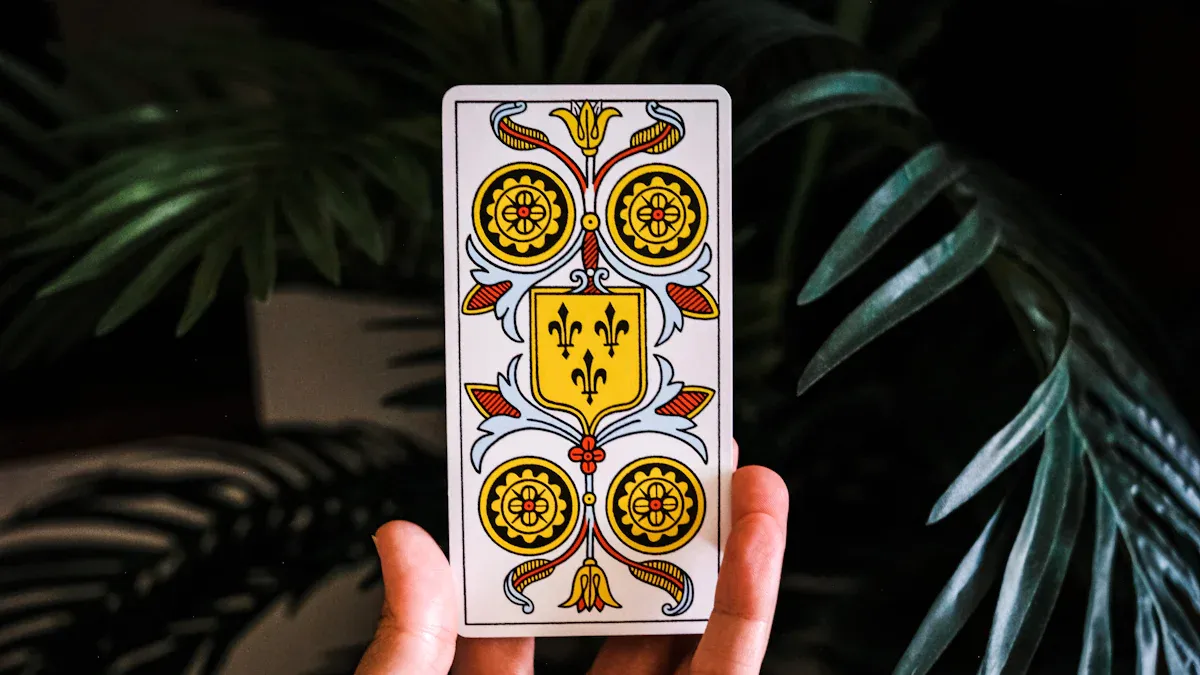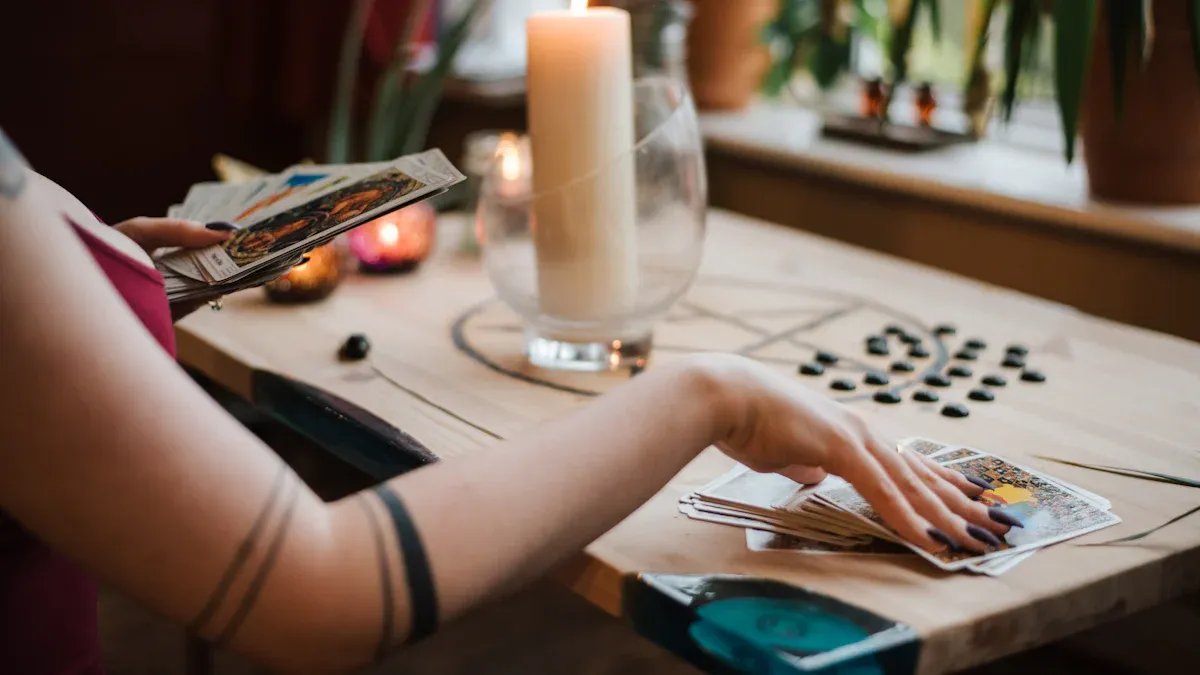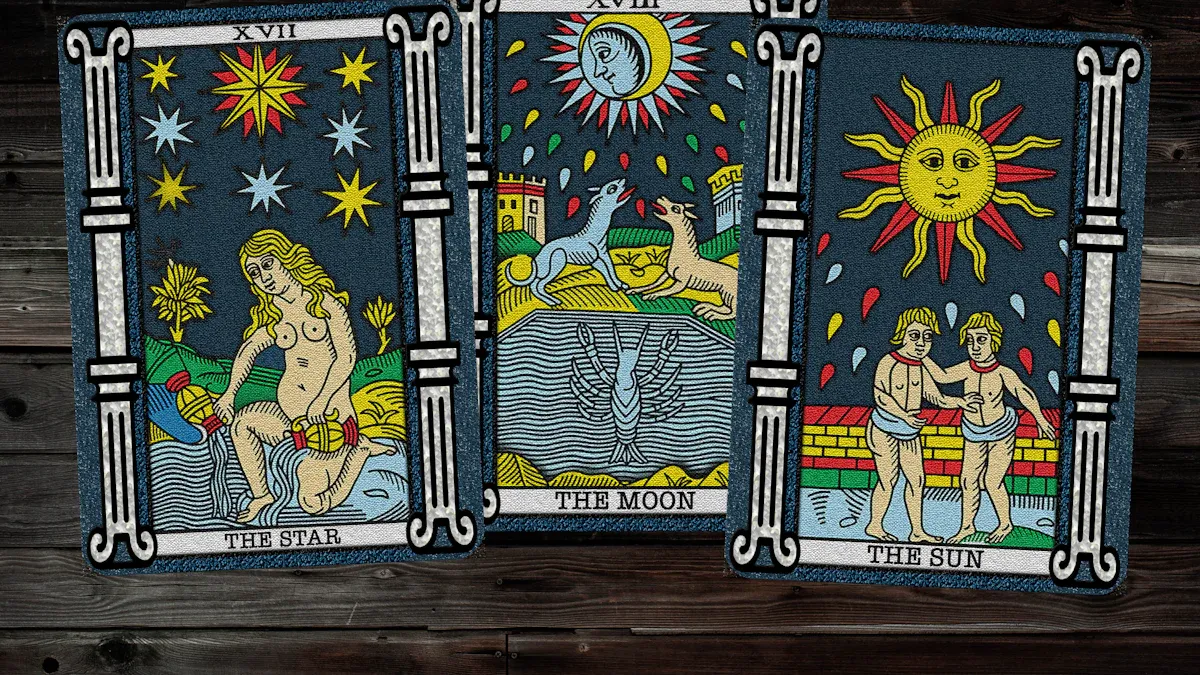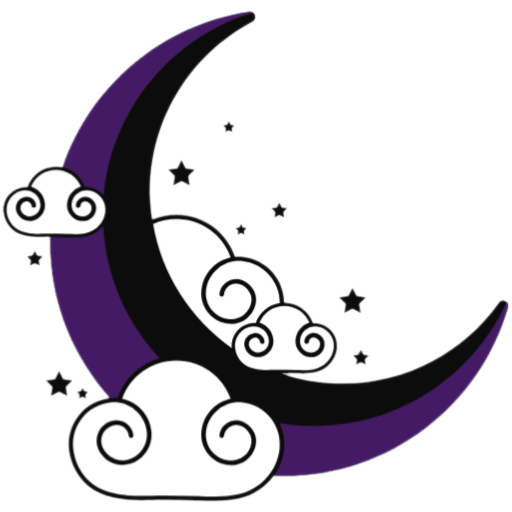
The Marseille Tarot cards have amazed people for hundreds of years. Their bright pictures and deep meanings make them popular for everyone. Each card shares a story, and learning these stories shows tarot’s true power.
When you look at the tarot de marseille, you’ll see its special design. It’s more than just cards; it helps you think and learn. Whether you’re starting tarot or using it again in 2025, being curious and practicing will help you understand the tarot’s wisdom.
Key Takeaways
Learn the two main parts of Marseille Tarot: Major Arcana teaches life lessons, and Minor Arcana shows daily happenings.
Find a quiet place to read. Set clear goals to focus your thoughts and energy on the cards.
Practice often with easy spreads like the three-card spread. This helps you feel confident and get better at reading.
Write in a journal after readings. This helps you connect with the cards and understand them more over time.
Join Tarot groups to share ideas and learn from others. This makes learning Tarot more fun and helpful.
Understanding the Marseille Tarot Card Deck

The Structure: Major Arcana and Minor Arcana
The Marseille tarot deck has two main parts: Major Arcana and Minor Arcana. Each part has a special purpose in readings. The Major Arcana has 22 cards about big life lessons. Cards like The Fool or The World show major life changes. The Minor Arcana has 56 cards about daily events. These cards are split into four suits: Cups, Swords, Batons, and Coins. Each suit stands for something different, like feelings, talking, creativity, or money.
Here’s a simple table to compare them:
Aspect | Major Arcana | Minor Arcana |
|---|---|---|
Structure | 22 cards, big life lessons | 56 cards, daily events |
Influence | Strong symbols, often spiritual | Practical, about everyday life |
History | From old tarot traditions | From playing card origins |
When you study the Marseille tarot, you’ll see how these parts connect. The Major Arcana shows the big ideas, while the Minor Arcana adds details.
Unique Features of the Tarot de Marseille
The tarot de marseille is special because of its design and style. Unlike modern decks, its Minor Arcana cards don’t have detailed pictures. They look like playing cards with patterns of symbols. This might be hard for beginners, but it helps you trust your intuition and use numerology.
The court cards in this deck have unique names: Valet (Page), Chevalier (Knight), Dame (Queen), and Roi (King). Some Major Arcana cards also have different names, like Papesse (High Priestess) and Pope (Hierophant). These differences give the deck a classic and old-fashioned charm.
Why the Tarot de Marseilles Stands Out
The tarot de marseilles has a long history that makes it unique. In 1937, Emmanuel Lalande showed its link to ancient traditions. Court de Gébelin even connected it to Kabbalah and hermeticism, adding to its mystery. Experts like Wirth and Maxwell admired the Marseille tarot as a true art piece. Maxwell called the 1760 Conver deck the most real version.
This deck is loved for its simple yet deep design. Its bright colors and clear lines make it beautiful. Its history gives it an authentic feel. Whether you’re new or experienced, the tarot de marseilles is full of things to learn and explore.
Interpreting the Cards
Major Arcana: Big Ideas and Life Lessons
The Major Arcana cards show big life lessons and themes. Each card tells a story about change and growth. For example, The Fool means starting fresh and taking chances. The World stands for finishing something and feeling complete. These cards show ideas like heroes, guides, or seekers. You can find these ideas in stories from all over the world.
The way people see these cards has changed over time. At first, tarot cards were just for games. Later, they became tools to find deeper meanings. This change shows how people started looking for personal and spiritual answers. When using the Major Arcana, think about your life. What big lessons or themes are happening for you now?
Minor Arcana: Everyday Life and Stories
The Minor Arcana talks about daily events and experiences. It has four suits: Cups, Swords, Batons, and Coins. Each suit stands for a part of life. Cups are about feelings and relationships. Swords focus on thoughts and talking. Batons show creativity and action. Coins deal with money and things you own.
Each card in the Minor Arcana has a main idea. For example, the Ace of Cups means new feelings or relationships. The Ten of Coins shows money success or stability. The court cards—Valet, Chevalier, Dame, and Roi—stand for people or traits. When you read these cards together, they tell a story that helps explain your situation.
Numbers and Symbols: Finding Hidden Meanings
Numbers and symbols help you understand the tarot de marseille better. Numbers like 1 mean new starts, and 10 means endings. The symbols, colors, and patterns on the cards give clues. For example, the Lovers card shows a man picking between two women. This stands for choosing between what you want and what’s right. It connects to old stories like Hercules’ choice in Greek myths.
Many readers use numbers to find deeper meanings in readings. Mixing the meanings of numbers and suits can show important insights. By noticing these details, you can learn more from the tarot de marseille.
Step-by-Step Guide to Reading Tarot de Marseille
Getting Your Space Ready and Setting Goals
Before reading tarot, make your space calm and quiet. Pick a peaceful spot where no one will bother you. You can light a candle, burn incense, or play soft music. These things help you feel connected to the cards.
Once your space feels good, think about your goal. Why are you doing this reading? Are you making a choice or understanding feelings? Say your goal out loud or write it down. This helps you focus and invites the tarot to guide you.
Shuffling, Picking Cards, and Using Spreads
Shuffling the cards is more than mixing them up. It’s how you connect with the deck. Shuffle in a way that feels easy for you. While shuffling, think about your question or goal. This puts your energy into the cards.
When ready, pick your cards. Beginners can try a 3-card spread. It shows the past, present, and future. For more details, use the Celtic Cross spread. It looks at your goals, problems, and possible results. For example, one person used it to beat writer’s block. They saw fear of fame was stopping them. This helped them finish a book chapter.
Understanding Cards Together and Telling Stories
Reading tarot is not just about one card. It’s about how the cards work together. Look for patterns or themes. For example, The Fool and Ace of Cups might mean a new relationship.
The tarot de marseille uses symbols to tell stories. Notice things like colors, body language, and old symbols. Think of the spread as a storybook. Each card is a chapter. By linking the cards, you find personal and deep meanings.
Practical Examples of Tarot de Marseilles Readings

Three-Card Spread: Past, Present, Future
The three-card spread is simple and great for beginners. It gives a quick view of your situation. Each card shows a time: past, present, or future. For example, the Ace of Cups in the past might mean a new relationship started recently. The Lovers in the present could show a choice or partnership now. The World in the future might mean success or finishing something important.
This spread is easy to understand and very helpful. Look at how the cards connect. Do they tell a story or show a problem? These links can help you find deeper meanings in your reading.
The Celtic Cross Spread: A Detailed Example
The Celtic Cross spread is popular because it gives lots of details. It uses ten cards, each with a special meaning. The first card shows the present, and the second shows challenges. Other cards reveal influences, hopes, and possible results.
Imagine you’re asking about your job. The Ace of Batons in the first spot might mean a new chance. If the Five of Coins is the challenge, it could warn about money problems. By seeing how the cards connect, you can find hidden clues and make better choices.
Real-Life Interpretation Example
Let’s say you’re asking about money. You draw the Ten of Coins, Ace of Swords, and Five of Cups. The Ten of Coins shows past money stability or inheritance. The Ace of Swords now might mean a new idea about money. But the Five of Cups in the future warns of loss or regret. The numbers (10 to 1 to 5) might show less money ahead. This could remind you to be careful with spending.
When reading, trust your feelings. Notice patterns, connections, and even card colors. These small details make your readings more clear and helpful.
Tips for Mastering Marseille Tarot Card Readings
Journaling and Reflecting on Your Readings
Journaling is one of the best ways to grow as a Tarot reader. After each reading, take a few minutes to write down your thoughts. What cards did you pull? How did they make you feel? What story did they tell? This practice helps you connect with the cards on a deeper level and builds a personal relationship with them.
Daily card pulls are another great habit. Draw one card each morning and reflect on its meaning throughout the day. Write about how it relates to your experiences or emotions. Over time, this will sharpen your intuition and help you notice patterns in your life. Journaling isn’t just about recording—it’s about learning to read the cards in a way that feels personal and meaningful.
Practicing with Others and Joining Communities
Reading Tarot doesn’t have to be a solo journey. Practicing with others can open up new perspectives and boost your confidence. Try reading for friends or family members. Their feedback can help you see the cards in ways you might not have considered before.
Joining Tarot communities, both online and in person, is another fantastic way to grow. These groups are full of people who share your passion. You can exchange tips, share readings, and learn from more experienced readers. Plus, being part of a community makes the learning process more fun and less intimidating.
Exploring Advanced Techniques and Resources
Once you’re comfortable with the basics, it’s time to dive deeper. Open reading techniques are a great place to start. Instead of sticking to rigid interpretations, let the cards guide you. Pay attention to the context of your question and how the cards interact with each other.
You can also explore the unique qualities of the Tarot de Marseille. Study the significance of the Major Arcana, the suits, and the numbers. Each part of the deck has something special to offer. Advanced books, workshops, and online courses can provide even more insights. The more you explore, the more confident you’ll feel in your readings.
Learning the Tarot de Marseille takes time, but it’s rewarding. Begin by understanding the deck’s parts and symbols. Practice reading the cards and linking them to your life. Doing this often will improve your skills and boost confidence.
Trust yourself when reading. The cards guide you, but your thoughts make them meaningful. Have fun and stay curious as you learn.
To learn more, check out Paul Marteau’s book on the Tarot de Marseille. It explains all 78 cards, their symbols, and history. You’ll also find tips to make your readings better.
Important topics to learn about:
Where tarot comes from and its history.
What Major Arcana cards mean.
How to read cards for better answers.
With practice and good tools, you’ll master the Tarot de Marseille. Get your cards and start learning today! 😊
FAQ
What makes the Tarot de Marseille different from other decks?
The Tarot de Marseille stands out because of its minimalist design. The Minor Arcana cards don’t have detailed illustrations, which encourages you to rely on intuition and numerology. Its historical roots and classic style also give it a timeless charm.
Can beginners use the Tarot de Marseille?
Absolutely! While the lack of imagery on the Minor Arcana might seem tricky, it’s a great way to develop your intuition. Start with simple spreads like the three-card spread and focus on learning the meanings of the suits and numbers.
How often should I practice reading Tarot cards?
Practice as often as you can! Daily card pulls are a great way to build your skills. Reflect on the card’s meaning throughout the day. Over time, you’ll notice patterns and feel more confident in your readings.
Do I need to memorize all the card meanings?
Not at all! While it helps to know the basics, you can always refer to a guidebook. Focus on understanding the symbols and trusting your intuition. The more you practice, the more natural it will feel.
Can I use the Tarot de Marseille for specific questions?
Yes, you can! The Tarot de Marseille works well for both general guidance and specific questions. Just set a clear intention before your reading. Whether it’s about love, career, or personal growth, the cards can offer valuable insights.


